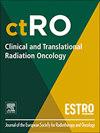Comparative analysis of target volume coverage and liver exposure in high-dose-rate interstitial brachytherapy and in silico MR LINAC-based stereotactic body radiotherapy plans for colorectal liver metastases
IF 2.7
3区 医学
Q3 ONCOLOGY
引用次数: 0
Abstract
Background
This study compared the plan quality and dosimetric parameters of single-fraction (SF) MR-LINAC (MRL)-based stereotactic body radiotherapy (SBRT) with delivered high-dose-rate interstitial brachytherapy (HDR-iBT) for colorectal liver metastases (CRLM).
Methods
Between August 2017 and March 2019, 26 patients with a total of 45 CRLM were treated in 28 sessions using HDR-iBT with 1 × 25 Gy and were retrospectively included in this study. For each patient, an in silico MRL-based SBRT plan was generated using the corresponding iBT CT dataset. In the iBT plans, a single fraction of 25 Gy was prescribed to the periphery of the gross tumor volumes (GTVs), while in the SBRT plans, the same dose was prescribed to the 80% isodose line covering the planning target volumes (PTVs). We compared the dosimetric properties of the delivered HDR-iBT and MRL-based SBRT plans.
Results
Median GTV was 3.83 cc (range: 0.13–92.58 cc) and median PTVSBRT was 15.47 cc (range: 2.68–164.17 cc). Both HDR-iBT and SBRT demonstrated excellent GTV coverage, with no statistically significant differences in GTV D98% (28.82 ± 2.57 Gy vs. 28.92 ± 0.88 Gy, p = 0.9). HDR-iBT achieved superior GTV D95% (31.62 ± 3.20 Gy vs. 29.22 ± 0.74 Gy, p < 0.01) and GTV D50% (64.71 ± 12.78 Gy vs. 30.22 ± 0.52 Gy, p < 0.01). Uninvolved liver dose metrics were higher in the SBRT plans compared to iBT, with a median relative difference in V5Gy of 5.29% (range: −13.69% to + 17.89%, p < 0.01) and a smaller relative difference in V10Gy of 1.5% (range: −7.74% to + 11.26%, p < 0.01).
Conclusion
Our comparison indicates MRL-based SBRT to liver lesions is feasible, achieving adequate target volume coverage without clinically relevant violations of organ-at-risk (OAR) constraints.
高剂量率间质近距离放疗和基于硅MR linac的立体定向体放疗治疗结直肠癌肝转移的靶体积覆盖和肝脏暴露比较分析
本研究比较了单组分(SF) MR-LINAC (MRL)立体定向放射治疗(SBRT)与高剂量率间质近距离放射治疗(HDR-iBT)治疗结直肠癌肝转移(CRLM)的计划质量和剂量学参数。方法:在2017年8月至2019年3月期间,26例共45例CRLM患者接受了28次1 × 25 Gy的HDR-iBT治疗,并回顾性纳入本研究。对于每位患者,使用相应的iBT CT数据集生成基于mri的计算机SBRT计划。在iBT计划中,在总肿瘤体积(gtv)的周围给予25 Gy的单一剂量,而在SBRT计划中,在覆盖计划靶体积(ptv)的80%等剂量线上给予相同剂量。我们比较了递送HDR-iBT和基于mrl的SBRT方案的剂量学特性。结果中位GTV为3.83 cc(范围:0.13-92.58 cc),中位PTVSBRT为15.47 cc(范围:2.68-164.17 cc)。HDR-iBT和SBRT均表现出良好的GTV覆盖率,GTV D98%无统计学差异(28.82±2.57 Gy vs 28.92±0.88 Gy, p = 0.9)。HDR-iBT取得优越的制造中心D95%(31.62±3.20 Gy vs 29.22±0.74 Gy, p & lt; 0.01)和制造D50%(64.71±12.78 Gy vs 30.22±0.52 Gy, p & lt; 0.01)。与iBT相比,SBRT计划中未受累的肝脏剂量指标更高,V5Gy的中位相对差异为5.29%(范围:- 13.69%至+ 17.89%,p < 0.01), V10Gy的相对差异较小,为1.5%(范围:- 7.74%至+ 11.26%,p < 0.01)。结论:我们的比较表明,基于mrl的SBRT治疗肝脏病变是可行的,可以实现足够的靶体积覆盖,而不会违反临床相关的器官危险(OAR)限制。
本文章由计算机程序翻译,如有差异,请以英文原文为准。
求助全文
约1分钟内获得全文
求助全文
来源期刊

Clinical and Translational Radiation Oncology
Medicine-Radiology, Nuclear Medicine and Imaging
CiteScore
5.30
自引率
3.20%
发文量
114
审稿时长
40 days
 求助内容:
求助内容: 应助结果提醒方式:
应助结果提醒方式:


